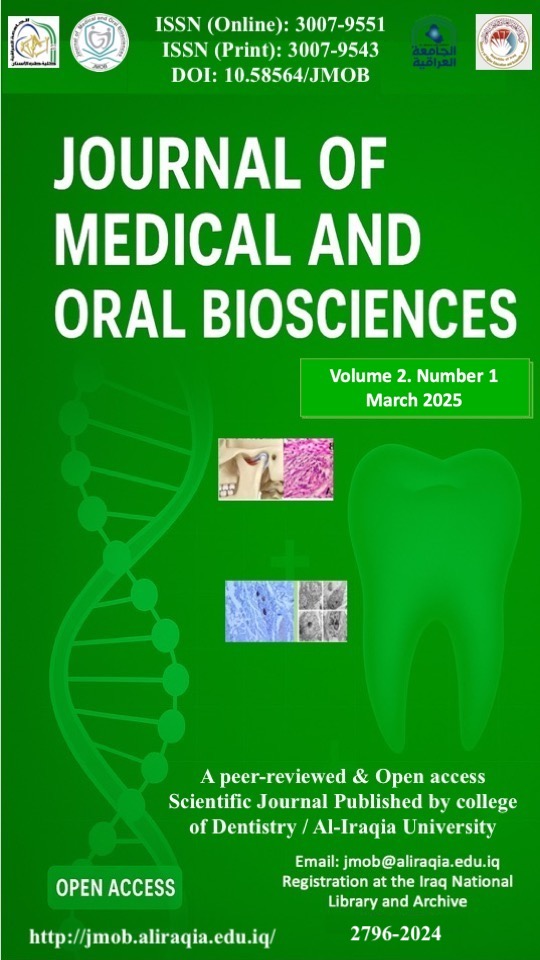The Desirable Impression Material and Technique Used For partial Dentures among Prosthodontist Impression Material Technique and partial Dentures among Prosthodontist
Main Article Content
Abstract
Impression materials are used to record intraoral structures for the fabrication of definitive restorations. Accurate impressions are necessary for construction of any dental prosthesis. The relationship between static and mobile oral structures must be reproduced accurately for an optimum cast. Making a cast in gypsum materials from an impression of dental anatomy aids dentists in designing and constructing removable and fixed prostheses. The accuracy of these final restorations depends greatly on the impression materials and techniques. This study aims to identify the type of materials and the methods used by Prosthodontist in their clinics to construct conventional partial dentures and to specify the type and design for removable partial dentures (RPDs); and to then compare them with those taught in dental schools. In conclusion, the polyvinyls and polyethers are more stable to deformation after setting has occurred. All have specific protocols for disinfecting that must be followed to prevent distortion of the material before pouring casts; however, the polyvinyls seem to be most impervious to different disinfection protocols.
Article Details

This work is licensed under a Creative Commons Attribution-ShareAlike 4.0 International License.
The Journal of Medical and Oral Biosciences uses a Creative Commons Attribution (CC Attribution-ShareAlike 4.0) and its license of (CC BY-SA 4.0). This license allows the authors to hold ownership of the copyright of their articles. However, it allows users to download, print, and extract. Reuse, archive, and disseminate the article as long as the authors get the appropriate credit and the source of the work. The license also ensures that the published articles will be available as widely as possible and can be located in any scientific archives.
References
1. Douglass CW, Watson AJ. Future needs for fixed and removable partial dentures in the United States. J Prosthet Dent. 2002 Jan;87(1):9-14. doi: 10.1067/mpr.2002.121204.
2. Bidra AS, Agar JR. A classification system of patients for esthetic fixed implant-supported prostheses in the edentulous maxilla. Compend Contin Educ Dent. 2010 Jun;31(5):366-8, 370, 372-4 passim. PMID: 20583505.
3. Scheller-Sheridan C. Basic Guide to Dental Materials. Hoboken, NJ: Wiley; 2013
4. Phoenix RD, Cagna DR, DeFreest CF. Stewart's clinical removable partial prosthodontics. Chicago: Quintessence; 2003 Jan.
5. Ward G. Impression materials and impression taking: an historical survey. Br Dent J 1961;110(4):118–9.
6. Rubel BS. Impression materials: a comparative review of impression materials most commonly used in restorative dentistry. Dent Clin North Am 2007;51(3): 629–42,
7. Schulein TM. Significant events in the history of operative dentistry. J Hist Dent 2005;53(2):63–72.
8. Hamalian TA, Nasr E, Chidiac JJ. Impression materials in fixed prosthodontics: influence of choice on clinical procedure. J Prosthodont 2011;20(2):153–60.
9. Scheller-Sheridan C. Basic Guide to Dental Materials. Hoboken, NJ: Wiley; 2013
10. Combe EC, Burke FJ, Douglas WH. Dental biomaterials, 1st edition. Boston: Kluwer; 1999.
11. Donovan TE, Chee WW. A review of contemporary impression materials and techniques. Dent Clin North Am 2004;48(2):vi–vii, 445-470.
12. Powers J, Wataha J. Dental materials foundations and applications. 11th edition. St. Louis (MO): Elsevier; 2017. 9. Reitz CD, Clark NP. The setting of vinyl polysiloxane and condensation silicone putties when mixed with gloved hands. J Am Dent Assoc 1988; 116(3):371–5.
13. Carr, A. B., Brown, D. T. (2010). McCracken's Removable Partial Prosthodontics-E-Book: Elsevier Health Sciences.
14. Carr, P. M.; Poland, W. W.; Tisor, L. J., 2005. Forage legume regeneration from the soil seed bank in Western North Dakota. Agron. J., 97 (2): 505-513
15. Schwartz R, Davis R. Accuracy of second pour casts using dual-arch impressions. Am J Dent 1992;5(4):192–4.
16. Mitchell ST, Ramp MH, Ramp LC, et al. A preliminary survey of impression trays used in the fabrication of fixed indirect restorations. J Prosthodont 2009;18(7): 582–8.
17. Kaplowitz GJ. Trouble-shooting dual arch impressions. J Am Dent Assoc 1996;127(2):234
18. Faria et al. Accuracy of stone casts obtained by different impression materials. Braz. oral res. vol.22 no.4 São Paulo Oct./Dec. 2008
19. Ceyhan JA, Johnson GH, Lepe X, et al. A clinical study comparing the three dimensional accuracy of a working die generated from two dual-arch trays and a complete-arch custom tray. J Prosthet Dent 2003;90(3):228–34.
20. Breeding LC, Dixon DL. Accuracy of casts generated from dual-arch impressions. J Prosthet Dent 2000;84(4):403–7.
21. Sajjan C. An altered cast procedure to improve tissue support for removable partial denture. Contemp Clin Dent 2010;1:103-6.
22. Day C, Lampraki A, Ridings D, Currell K. (2016). Intellectual disability and substance use/misuse: a narrative review. Journal of Intellectual Disabilities and Offending Behaviour.
23. Bosniac P, Rehmann P, Wöstmann B. (2019). Comparison of an indirect impression scanning system and two direct intraoral scanning systems in vivo. Clinical oral investigations. 23(5), 2421-2427.

